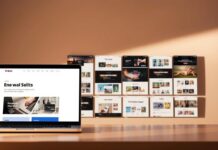Embracing the role of a freelance designer can be a transformative experience, allowing you to unlock your creative potential while enjoying the flexibility of a design career. This path offers graphic design opportunities across diverse industries, enabling you to choose projects that resonate with your skills and passions. As a freelance designer, you can explore various creative avenues, shaping a unique career that not only fulfills your artistic aspirations but also thrives in today’s competitive landscape.
The Growing Demand for Freelance Designers
The landscape of work is evolving, with businesses increasingly recognizing the value of tapping into the freelance talent pool. The demand for freelance designers has surged, driven by the need for specialized skills that can be accessed on an as-needed basis. Reports highlight that industries such as technology, marketing, and media are at the forefront of this trend, translating into a remarkable freelance market growth.
Statistics reveal a significant rise in freelance opportunities, with many companies seeking to enhance creativity and innovation through flexible working arrangements. Creative freelance work allows designers to engage with diverse projects and clients, opening doors to unique collaborations that were previously unavailable in traditional employment settings.

This increase in demand does not only present an opportunity for designers to showcase their skills, but it also reflects a broader societal shift toward valuing flexibility and remote work. As the freelance market continues on its upward trajectory, designers who adapt to this trend will find a wealth of possibilities waiting for them.
Understanding the Skills of a Successful Freelance Designer
A successful freelance designer needs a combination of creative and technical skills. Proficiency in design software such as Adobe Creative Suite is vital for executing concepts effectively. Beyond software expertise, understanding core design principles including color theory and typography enhances the ability to create visually appealing work. These essential design skills form the foundation of every successful graphic designer’s repertoire.
Problem-solving capabilities play a crucial role in navigating client requirements and overcoming design challenges. Collaboration with clients requires strong communication skills to ensure that their vision is accurately translated into design. Additionally, freelance designers often manage multiple projects simultaneously, which necessitates effective time management and organizational skills.
Continuous learning is a fundamental aspect of remaining competitive as the design industry evolves. Being open to acquiring new knowledge and honing essential design skills contributes to a designer’s growth and adaptability. Emphasizing these aspects will set aspiring designers on the path to becoming successful freelance designers.
Building an Impressive Portfolio
A strong freelance designer portfolio serves as a critical tool for attracting clients and showcasing one’s creative skills. It is essential to include a variety of works that reflect diverse design projects across multiple industries. This diversity not only highlights versatility but also demonstrates the designer’s ability to adapt to different client needs and market trends.
Showcasing Diverse Projects
When curating a freelance designer portfolio, it is important to include a selection of diverse design projects. These projects can encompass various styles, mediums, and industries, illustrating not just technical skills but also creative thinking. Incorporating different types of work allows potential clients to see a well-rounded designer capable of handling a wide array of tasks. Unique projects can foster engagement and intrigue and set the designer apart in a competitive market.
Quality vs. Quantity in Portfolio Development
In the realm of portfolio quality, the emphasis should always be on showcasing high-quality work rather than overwhelming clients with too many pieces. Each project displayed should represent the designer’s unique style, skills, and creativity. A meticulously crafted freelance designer portfolio with thoughtful selections creates a stronger impact than a larger collection that lacks focus or cohesion. Every piece included should contribute to a compelling narrative about the designer’s talents and capabilities, making the portfolio not just a collection but a story of their journey.
Essential Tools for Freelance Designers
In the world of freelance design, having the right tools makes a significant difference in efficiency and creativity. Mastery of design software is crucial for producing high-quality work. Understanding and leveraging essential freelance designer tools can set professionals apart in a competitive market. Equally important is staying informed about emerging design technologies that can enhance workflows and innovate project outcomes.
Mastering Design Software
First, familiarizing oneself with industry-standard design software tools like Adobe Creative Suite and Figma is vital. These applications offer comprehensive features that enable designers to create stunning graphics and layouts efficiently. Mastery of these tools not only boosts productivity but also elevates the quality of the final product. Engaging in online tutorials and workshops can help freelancers refine their skills and stay ahead of the curve.
Staying Updated with Emerging Technologies
Looking beyond traditional design software, incorporating emerging design technologies like artificial intelligence and virtual reality into projects can provide a competitive edge. Understanding how these innovations can be integrated into everyday work can open new avenues for creativity and enhance client offerings. Freelancers who adopt these cutting-edge tools demonstrate adaptability and a commitment to delivering modern solutions.
Networking Strategies for Freelance Designers
Effective networking for freelance designers can open doors to new opportunities and collaborations. Engaging with the design community is paramount for building relationships that lead to future projects. Start by joining online platforms that cater specifically to designers. Websites like Behance and Dribbble not only showcase your work but also allow you to connect with other creatives and potential clients.
Attending industry events presents another valuable avenue for professional networking. Conferences, workshops, and local meetups enable freelancers to meet peers and industry leaders. These face-to-face interactions can foster trust and rapport, making it easier to collaborate on projects or get referrals. Joining social media groups dedicated to design can facilitate ongoing connections, where members share resources, tips, and job leads.
Building a strong network requires consistent effort. Providing support to fellow designers can enhance your visibility within the design community while encouraging them to reciprocate. Sharing your work and insights on social platforms amplifies your reach and links you to a broader audience. By actively participating in discussions and collaborations, freelance designers can cultivate fruitful relationships that enhance their careers.
How to Market Yourself Effectively
Marketing effectively as a freelance designer plays a crucial role in attracting clients and achieving a steady flow of projects. Social media marketing provides a platform to showcase unique designs and interact directly with a target audience. Utilizing channels such as Instagram and LinkedIn can significantly enhance your online presence for designers, allowing you to highlight your creativity and expertise in a visually appealing way.
Utilizing Social Media Platforms
Different social media platforms offer unique opportunities for marketing for freelance designers. Instagram stands out for its visual-centric nature, making it ideal for displaying design portfolios. Regularly posting engaging content, utilizing relevant hashtags, and connecting with like-minded individuals can enhance visibility. LinkedIn serves a different purpose, focusing on professional networking. Sharing insights, participating in design discussions, and connecting with potential clients can lead to fruitful collaborations.
Creating an Engaging Online Presence
An engaging online presence for designers goes beyond just sharing work. It involves creating a cohesive brand identity across all platforms. Consistent branding helps potential clients recognize and remember your design style. Creating informative content such as blogs or tutorials related to design can position you as an expert in the field, fostering trust and attracting more clients. Interacting with your audience through comments and messages strengthens connections and encourages ongoing engagement.
Mastering Time Management and Freelance Work-Life Balance
Time management for freelancers is essential, especially when navigating multiple projects and tight deadlines. Establishing clear objectives at the outset enables designers to maintain focus and align their efforts with client expectations. Utilizing project management tools, such as Trello or Asana, can further streamline workflow and improve efficiency. Prioritizing tasks is another vital aspect that greatly enhances productivity. By categorizing tasks based on urgency and importance, freelancers can allocate their time more effectively.
Achieving a work-life balance design career can feel challenging amidst heavy workloads. It is crucial for freelance designers to schedule time for personal pursuits and creative development. Setting boundaries around work hours helps to maintain mental well-being while fostering inspiration. Utilizing productivity tips, such as the Pomodoro Technique, can create structured work intervals followed by short breaks, ensuring sustained focus without burnout. Balancing professional commitments and personal life is key to long-term success in this dynamic field.
Freelance Designer: Navigating Industry Nuances
In the freelance design industry, understanding design requirements is essential for success. Each sector, from technology to marketing, has unique standards that designers must grasp. For example, tech companies may prioritize sleek, user-friendly interfaces, whereas marketing agencies often look for vibrant visuals that communicate brand identity. This underscores the importance of adapting to client needs, ensuring that your design solutions resonate with their objectives.
Being attuned to industry specifics allows freelance designers to deliver tailored results. For instance, compliance-focused sectors demand strict adherence to guidelines, which can dictate design choices. By staying informed about these nuances, designers build a solid reputation for reliability and professionalism. Clients appreciate when their vision aligns with industry norms, reinforcing the notion that understanding design requirements goes hand in hand with successful project execution.
The Importance of Continuous Learning
The design field is not static; it is continuously evolving. As technology advances and trends shift, freelance designers must embrace continuous learning for designers. Engaging in professional development in design through workshops, online courses, and webinars allows designers to stay current with emerging tools and techniques. This ongoing education serves as a foundation for skill enhancement, enabling designers to adapt to new challenges and client expectations.
Moreover, actively participating in learning opportunities fosters creativity and innovation. Exposure to different perspectives and methodologies expands a designer’s toolkit, ultimately improving their project outcomes. Lifelong learning not only keeps skills sharp but also enhances overall confidence in navigating the complexities of the design industry.
In a competitive market, those who prioritize skill enhancement through continuous learning stand out. Designers committed to their growth bolster their relevance and position themselves for future opportunities. The journey of education does not end; it is an ongoing commitment vital for sustained success in the ever-changing landscape of design.
Conclusion
In the expansive realm of freelance design, success is not merely a destination but a journey filled with endless creative opportunities. By leveraging the skills discussed throughout this article—such as building a compelling portfolio, establishing strong networking connections, and committing to continuous learning—freelance designers can effectively navigate this dynamic landscape while unlocking their full potential.
Embracing flexibility in your work means you’re in a unique position to explore diverse projects and client needs. Each of these experiences not only enhances your skills but also propels you toward greater freelance designer success. Remember, the design world is constantly evolving, which presents exciting challenges and opportunities that can inspire your creativity and innovation.
The path to fulfillment as a freelance designer is paved with proactive steps. By applying the insights gained here and embracing a mindset of growth, you’re well on your way to discovering your own creative opportunities in design. Invest in your craft, stay informed, and cultivate a community around you—these actions will contribute to a thriving freelance career that resonates with passion and purpose.



